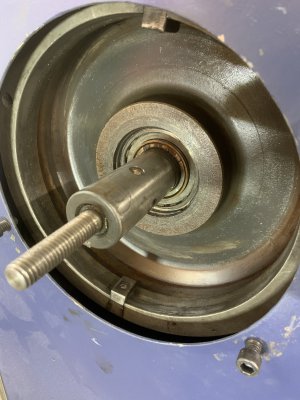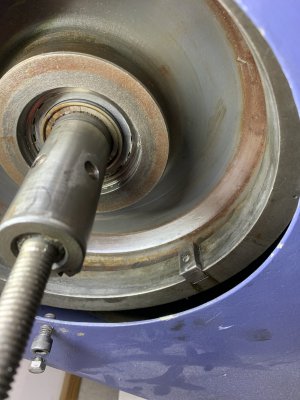So I've had quirky issues with the clutch on this machine ever since I got it. The worst of the issues is that the clutch assembly rattled when the clutch was disengaged. I've had the clutch apart a few times, a couple just to clean grease off the clutch plate. The driven pulley has a grease zerk to lubricate the bearing. Yes, it is grease, there is even a plate on the back of the lathe saying to grease it at some frequency. I had replaced that bearing originally. PIA to find, paid dearly for a NOS bearing.
Yesterday I had trouble starting the lathe. The VFD frequently faulted out with an over current on acceleration message. I could go in and tweak some VFD parameters, there is a whole slew of 'features' that can be used. And it's not really drawing more current than it should on acceleration if the VFD's current display is to be believed. (Note the LED segments in the above picture are also current draw as reported by the VFD through one of the analog outputs). A little bit of diagnosing and I realized the problem was that the startup was trying to turn the spindle even with the clutch disengaged. The clutch lever is complicated as one direction engages the clutch the opposite direction engages a cone brake on the spindle. I worried something was messed up inside the headstock. My understanding is that isn't easy to dissassemble and reassemble. I've watched a few YouTube videos on people doing that, Maching360 had a good one although I believe that channel has disappeared.
I decided to work the clutch end first. Fix the known quirks.
The clutch is basically integrated with the driven pulley, three belts from the motor. Taking the cover off, the exposed end looks like this:

The spider assembly is pulled in by center rod til it cams over and holds the clutch engaged. There is a spring loaded pin that registers on the pressure plate ring of holes, that allows the clutch to be adjusted to just enough pressure to cam over and stay locked. The outer arms of the spider press on the pressure plate.
Here's the pressure plate with the spider removed. The first of these two pictures is with the center rod from the clutch lever in the engaged position, the second in the disengaged position. One of the tricks on these clutches is getting the spider on correctly. It threads onto both the center rod and the large diameter thread on the back plate. (The nut on the rod above is redundant, but factory design). The trick is to start the spider threading onto the rod before the center drum. My spider likes 12 full turns onto the rod before starting it threading onto the drum. Otherwise the spring, inside the spider, doesn't have enough pressure to hold the clutch disengaged, and it will drag and spin somewhat.


Here's a picture of the pressure plate coming off. Note that it is held in place only by the spider. The pressure plate has a slot in the inner hole that is engaged by a dog in the back part of the pressure plate (what would be a flywheel in a car?). Note the small bright springs behind this plate. The are often damaged or in part missing on the older monarchs of this design. I had previously replaced these. They help push the outer pressure plate off the clutch disc when it is disengaged.

Completely removing the outer pressure plate and the clutch plate, here's the inner pressure plate. It's held onto the center shaft by two set screws, which each have a locking setscrew on top. You can clearly see the dog that engages with the outer pressure plate in this picture. Removing the two setscrews, and the inner pressure plate slides off. The clutch is completely gone, yet I still noticed here that the pressure plate and pulley wanted to rotate together. Trying to figure out what could be dragging, that doesn't make sense for anything in the headstock.


I went ahead and removed the large plate that acts as a belt guard too. Here's a picture of the pulley, belts and motor. You can see the key that the back pressure plate mated with. Also one of the dogs in the pulley that engaged the clutch disc.

The drive dogs engage in the clutch disc perimeter. The disc essentially floats on those dogs, nothing else holds the clutch disc. Over the 75+ years of this lathe's life those dogs(keys?) take some abuse. You can see in this picture where they had been hammered away over the years. About 17 thousands of wear. That leaves the clutch disc loose and prone to rattle when disengaged. Obviously when engaged it is clamped between the two pressure plate halves and held pretty well.

I wanted to reduce that play so the disc was less likely to rattle when disengaged. Adam Booth (aka Abom79 on YouTube) cut new slots in the perimeter of the clutch disc. I widen mine from .500 to .540, .020 off each side. And then made new dogs/keys that were stepped, .500" in the pulley side, .540 on the clutch disc side, as widening the inside of the pulley would be a more difficult setup.

I was test fitting the new dogs in the pulley when it occurred to me that the bearing between the pulley and the center shaft was a likely culprit of my drag problems. Sure enough, spinning the pulley by the belts, I could feel a lot of roughness in that bearing. The bearing that I'd replaced earlier, as mentioned above.
I pulled the pulley, here you can see the end of the bearing. It's a 2 5/8" OD x 1 5/8" ID x 2 3/8" double row needle bearing. I tried to press the bearing out after removing the retaining rings, ended up with a pile of needles. Must have not engaged the outer race of the bearing. The needles don't look very impressive. Here they are after I picked them up off the floor. The chips and debris is from the floor, but most of the needles have rust, and some of them are damaged (look near the bottom). That would explain the rough feeling. I'm guessing the rust must have been included as a NOS feature. The exterior of the bearing when installed look fine.






















